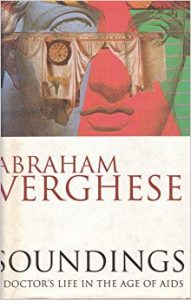 Clinical work often involves intense interactions with patients and their carers, and sometimes this can be very draining. Coming to terms with the nature of care, and negotiating the balance between the demands of home and a clinical calling is a complex process which is not easily described. In every situation, and for every individual, there will be different choices and accommodations. Abraham Verghese gave an unforgettable account of his struggles with these choices in Soundings, his first book, published in 1994.
Clinical work often involves intense interactions with patients and their carers, and sometimes this can be very draining. Coming to terms with the nature of care, and negotiating the balance between the demands of home and a clinical calling is a complex process which is not easily described. In every situation, and for every individual, there will be different choices and accommodations. Abraham Verghese gave an unforgettable account of his struggles with these choices in Soundings, his first book, published in 1994.
In America Soundings was published as My Own Country, but a more direct description of its content is the subtitle of Soundings: a doctor’s story of a town and its people in the age of AIDS. Verghese was marooned by circumstance in rural Tennessee, unable to obtain the lucrative residencies in metropolitan private hospitals that were the natural destinations of his WASP colleagues, mainly because he was an outsider of Ethiopian and Indian descent and education. But there in the rural Tennessee from 1984-1990 he found himself caring for the first victims of the New York AIDS epidemic, as young homosexual men who had fled their conservative backgrounds for New York city returned home to their families, bringing with them their fatal disease. He also treated a patrician mining consultant who had contracted AIDS after an infected blood transfusion, and who had gone on unwittingly to infect his wife; and a haemophiliac who had contracted HIV through infected plasma.
As the local specialist in infectious diseases Verghese is the only doctor for the AIDS population in the area. His resources are stretched, particularly his time, but also his emotional reserves. His wife expresses her resentment at the way AIDS has come to dominate his life, and also expresses her fear in these early days of AIDS care that he and she and their children will end up infected too. The interactions with the people with HIV and their families, some newly reconciled, some with many stored-up hurts, cause Verghese to examine his own family relationships. But even as he does so, he finds himself neglecting those relationships under the pressure of his clinical obligations.
During his work with other clinicians in these early years of the HIV epidemic, Verghese identifies the fears of the nation. He soon discovers which gastroenterologist, for example, is prepared to do an endoscopy on someone with AIDS and which one will provide less than ideal follow-up care. A dentist is horrified to find that a patient who bled during a tooth extraction turns out to have HIV. Questions of confidentiality arise, with patients unwilling to divulge their HIV status to carers who may be at risk while unaware of the need to take precautions.
It was particularly draining to have no treatment for HIV, other than the palliative measures for opportunistic infections. Nevertheless, Verghese became the doctor-confidant for people who could not afford to let their HIV status be known. But whilst he heard the patient stories, he was acutely aware of his own failing as a doctor. He came to see the ritual of the bedside examination, the careful processes of taking a pulse and auscultation of the lungs as what he has to offer, and what patients value. (Today Verghese is a champion of the bedside examination at Stanford University, through the ‘Stanford 25’.) Eventually there came the advent of AZT, and possibilities of treatment, although, even then, patients would decline and die. Verghese finds himself breaking up emotionally, and finds his professional armour dissolving. In the end he elects to leave for Iowa and recharge his batteries, worn out by the struggle, and feels guilty at his resultant sense of liberation.
Throughout this book Abraham Verghese describes his very human reactions to the people and the situations that he meets, unafraid to appear weak, impotent, and human. As a result, it is one of the great portraits of the medical life.
Verghese, Abraham (1994) Soundings: A Doctor’s Life in the Age of Aids, London, Phoenix House
Published in 1994 in America as My Own Country, Simon and Schuster
The Stanford 25, at https://stanfordmedicine25.stanford.edu/the25.html